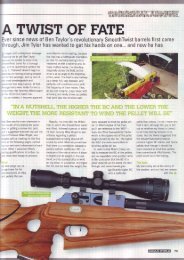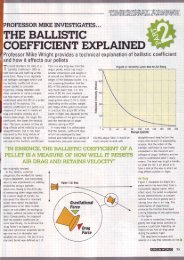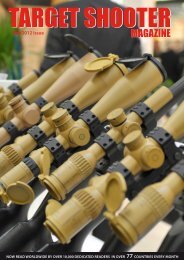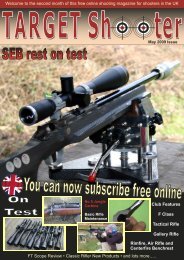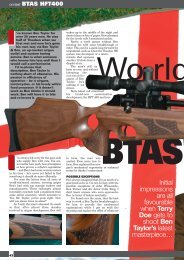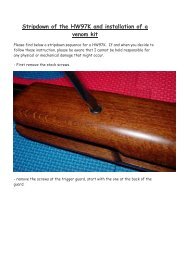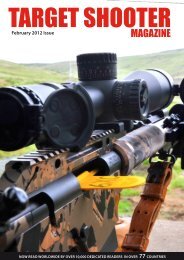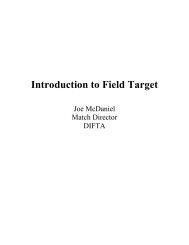Target Shooter 1
Target Shooter 1
Target Shooter 1
Create successful ePaper yourself
Turn your PDF publications into a flip-book with our unique Google optimized e-Paper software.
provide them with the opportunity to increase<br />
accuracy in shot placement.<br />
This is why we need wind flags – to<br />
attempt to indicate the amount of deflection<br />
that the wind will subject the bullet to, which<br />
will of course, depend on the wind’s speed<br />
and direction. Anything out there, between<br />
you and the target, that will indicate the speed<br />
and direction of the wind will clearly give you<br />
a better opportunity of hitting your aim-point<br />
– providing you can interpret the ‘condition’.<br />
If we adopt the Swiss mathematician<br />
Daniel Bernoulli’s theories for shooting, we<br />
begin to see what effect the wind has on a .22<br />
calibre rimfire bullet, over specific distances.<br />
The diagram to the left is a metric adaption of<br />
one produced by Joe Haller.<br />
benchrest and even F-classers shooting at greater<br />
distances. The wind flag is capable of imparting a<br />
lot of information to the shooter which can and will<br />
A wind blowing from 3 o’clock with a<br />
velocity of around 9-10 mph, will cause<br />
the bullet to impact approximately 25 to<br />
26mm to the left and about 6mm high.<br />
From the 9 o’clock direction it would impact<br />
approximately 25 to 26mm right and 6mm<br />
low. This change in elevation is down to the<br />
‘Bernoulli Effect’ and the fact that most<br />
modern target rifles have a barrel with a<br />
right-hand twist.<br />
Obviously, a 1 mph wind from the right will move<br />
the bullet a tenth as far. A similar<br />
strength wind from the 4 or 5 o’clock<br />
direction will drive the bullet less to the<br />
left but still slightly high. A wind from<br />
the 6 o’clock direction will raise the<br />
bullet impact slightly and a 12 o’clock<br />
‘headwind’ will drive the bullet<br />
slightly low.<br />
The table below lists the constraints<br />
for 9-10 mph winds and could<br />
theoretically be used. Just remember<br />
the wind always does what you<br />
expect it to - until it doesn’t! Sorry but<br />
there it is! Wind deflection is all about<br />
reading the flags and the information<br />
listed below are at best quite good<br />
‘estimates’.<br />
When actually shooting however,<br />
you will need to consider other<br />
issues like barometric pressure and<br />
temperature.<br />
<strong>Target</strong> <strong>Shooter</strong> 47



